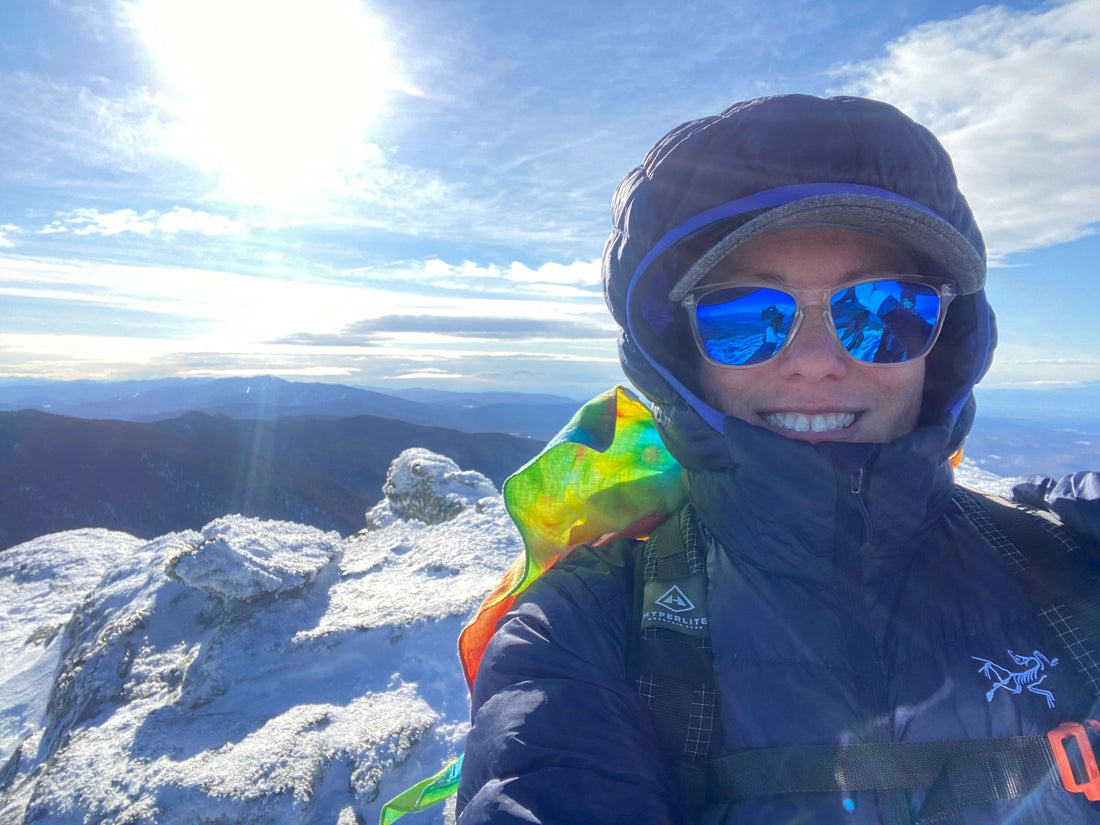By: Rebecca
As the seasons start to change, and summer leans into fall, seasoned hikers of New England begin the (sometimes) overnight transition from lightweight backpacking to carrying what sometimes feels like everything but the kitchen sink. There’s no knowing what you may encounter on the trails during what we call “shoulder season” and in order to hike safely we sacrifice the speed and comfort of summer packs for the security of a myriad of hiking gear and a slower pace.
Shoulder season in the Northeast can last anywhere from early September to early December, or in the spring, mid March to mid June, meaning our gear is dictated by shoulder season conditions for over half the year. Sometimes it feels like I’m carrying unnecessary weight up and down mountains more than I’m not, but the added poundage equates to stronger leg muscles and less chances of being unprepared in an emergency.

How To Pack For Shoulder Season Hiking
Before going into the nitty gritty, I feel that it’s important to state that my gear list is not the end all be all of gear lists. Everyone has different items they consider necessary so as long as you’re comfortable with your own setup and aren’t endangering yourself feel free to use my list as simple suggestions for what you could add to your own kit.
The easiest way to go about building your kit is to start with the bare minimum and go from there. Namely, the Ten Essentials. Every hike, regardless of season, should elicit you going through your pack to make sure that you have at least the ten essentials in it, (and that you know how to use them). These items have been explicitly chosen by The Mountaineers back in 1974 and are still considered the most important things you should carry to this day.
Navigation
Headlamp
Sun Protection
First Aid
Knife
Fire
Shelter
Extra Clothes
Extra Food
Extra Water
While many of these items are going to remain the same regardless of season (headlamp, navigation, etc) some of them require a little more thought depending on the seasons. The amount of clothes, shelter, food, and water you carry are going to change on a case-by-case basis, but for the most part seasonality will determine how much and what specifically you carry for each of these four items.
Shoulder Season Food & Water
During the spring and fall in New England your water usage will fluctuate and sources may or may not be flowing. Depending solely on filtering water while hiking is never a wise choice, however, everyone requires different amounts of water to be well hydrated. Personally, I tend to sweat more than most people so unless I’m only going on a short hike (under 3 miles) I carry 40 ounces of water at all times. Though that may sound like a lot, unless I’m hiking on flat ground (which is almost unheard of in New England) I am exerting enough energy to elicit sweating which in turn means I need to replenish that lost fluid. I carry a Katadyn Befree filter on all my hikes, even in the winter, however I typically don’t use it when hiking in full winter conditions. Although you may not think you’re losing fluid during the colder months, you are actually just as at risk for becoming dehydrated in winter conditions, so carrying extra water is still essential.
Another important factor to consider in shoulder season when it comes to water is the possibility of it freezing. I recommend that you carry your water bottle upside down in your side pockets (make sure the lid is on tight) because water freezes from the top down and having your water bottle lid frozen shut is never a good time. Some people will use an insulating sleeve (or even wool socks) to keep their water from freezing, however I don’t.
The amount of food that you carry on a hike will also vary depending on the length and how much you eat. Keeping your snacks easily accessible (in shoulder or hip belt pockets) means you won’t have to struggle to get to them in your pack. The less time you spend standing still when it’s cold the better. You also want to make sure you’re carrying extra food. This doesn’t mean you have to add a ton of weight to your pack, either. Because of companies like Readwise, which makes lightweight, nutritious food for all your dietary needs, and covering every meal, you can afford to add a few extra snacks to your pack on a day hike without feeling bogged down.
Shoulder Season Shelter
Carrying an emergency shelter is, in my opinion, a necessity for every hike. Thankfully, there are emergency shelters that weigh ounces and can be life-saving. On all day hikes I carry an emergency bivy, space blanket (two person), and hand warmers. If something were to happen where I needed to spend the night outside, I may not be cozy, but I won’t die if I stay in my emergency shelter. Depending on how much added weight you want to carry, you can even bring a sleeping bag or one person tent on hikes, however, I don’t.
Shoulder Season Clothing
What I wear on hikes is entirely dictated by the weather and where I will be hiking. Shoulder season is a great time to practice the art of layering. You may start off the hike in a base layer (long sleeve shirt and leggings), then add a mid layer jacket and gloves as you get higher in elevation and the temperature drops. On the other hand, you may start off in the morning wearing all your layers and as the day warms up begin to strip. Temperature regulation is key because sweating too much can lead to hypothermia. It takes time and practice hiking, but learning if you run hot or cold is the best way to figure out how much clothes to carry on top of what you wear.
Shoulder Season Example Clothing
In the spring and fall I will wear either a long sleeve 250 merino shirt or a t-shirt depending on how cold it is (50 degrees or colder at the trailhead will mean I wear a long sleeve shirt). I wear either full length leggings or capris depending on the temperature at the trailhead, too. Additionally, in my pack I carry a puffy jacket, outer layer rain jacket, gloves, buff, and hat along with extra socks.
Shoulder Season Footwear
In New England what you wear for traction is a big topic. Because snow can last all the way into June, and come as early as September, it’s important to carry some form of traction if you know that the trail conditions are going to contain snow or ice. I prefer to carry only microspikes unless I know that the snow pack is going to be soft or unconsolidated. Staying on top of trail conditions, talking to other hikers, and checking the forecast are the best ways to find out what kind of conditions you will be experiencing. There is nothing more exhausting (and potentially dangerous) than spending an entire day post holing through feet of melting monorail.

Final Thoughts
Making peace with the likelihood that you will be slowing down and experiencing a variety of conditions during the shoulder seasons in New England is just part of the hiking experience. You may go out in a t-shirt and shorts one day and then the next be pulling out your winter puffy. Finding what system works best for you so that you can have a fun (and safe) hike takes time and experience, but I encourage everyone to embrace the polarities of shoulder season hiking because the more varied the hikes the better you will get as a hiker.
Author Bio
Rebecca is an avid hiker based out of New Hampshire and the White Mountains are her playground. She is a bonafide list-o-holic and is working on hiking all the trails in the White Mountains of New Hampshire as well as the New England 100 Highest Peaks in fourteen months. Completing this would make her the first known woman to finish this in a set amount of time. She is a trail adopter with the White Mountain National Forest and encourage everyone who makes use of hiking trails to give back through volunteering, when possible.


